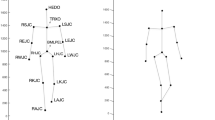Author’s Preface
I have heard over the years that dance therapists have found this study of clinical value to them, and I am very gratified by that. It makes doing the research make sense. I would like, however, to include one strong note of caution regarding the interpretation and application of these movement descriptions. There is the danger that one may interpret the patterns too liberally based on a written report and verbal descriptions. For example, "Fragmentation" in the various forms delineated here is something qualitatively different from "everyday" forms of awkward or poorly coordinated movement. Optimally, the report of this study should be accompanied by videotape examples so there would be no question as to what is meant, but this is not possible. I can only ask that you be very strict in your interpretation of these descriptions and err, if necessary, in the direction of "no fragmentation."
Twenty-Two psychiatric patients were observed behind a one-way screen without sound during individual psychotherapy sessions. Four observers trained in rating a 70-item "Movement Diagnostic Scale" developed by the author completed the inventory on each patient from one viewing. Observer reliability was .78 for ratings on all items. Presence of items clustered under the category Fragmentation correlated significantly with more than two hospitalizations and/or a diagnosis of chronic schizophrenia. Evidence of a correlation between items grouped as Reduced Mobility and amount of phenothiazine medication is reported along with discussion of a series of possible correlations between specific movement profiles and specific psychodiagnoses. Weekly observations of one patient for 7 weeks are presented to demonstrate the scale’s value as a measure of change.
Similar content being viewed by others
References
Bartenieff, I., & Pauley, F. Choreometric profiles and the choreometric coding book. In A. Lomax (Ed.),Folk Song Style and Culture. Washington: American Association for the Advancement of Science, Publication No. 88, 1968.
Condon, W. S. Linguistic-kinesic research and dance therapy.Proceedings of the Third Annual Conference of the American Dance Therapy Association. Maryland: American Dance Therapy Association, 1968, 21–42.
Kline, N. S., & Lehman, H. E. (Eds.),Psychopharmacology. Boston: Little & Brown, 1965.
Lowen, A.Betrayal of the body. New York: Macmillan, 1967.
Reich, W.Character analysis. New York: Orgone Institute Press, 1949.
Rennie, T. A. Analysis of one hundred cases of schizophrenia with recovery.Archives of Neurology and Psychiatry, 1941,46, 197–229.
Wittenborn, J. R. The dimensions of psychosis.The Journal of Nervous and Mental Disease, 1962,134, 117–128.
Author information
Authors and Affiliations
Additional information
Editors’ Note: In response to professional requests, Dr. Davis’ article is being republished. It originally appeared inProceedings of the Fifth Annual Conference of the American Dance Therapy Association, 1970, 25–45.
Rights and permissions
About this article
Cite this article
Davis, M. Movement characteristics of hospitalized psychiatric patients. Am J Dance Ther 4, 52–71 (1981). https://doi.org/10.1007/BF02579526
Issue Date:
DOI: https://doi.org/10.1007/BF02579526




